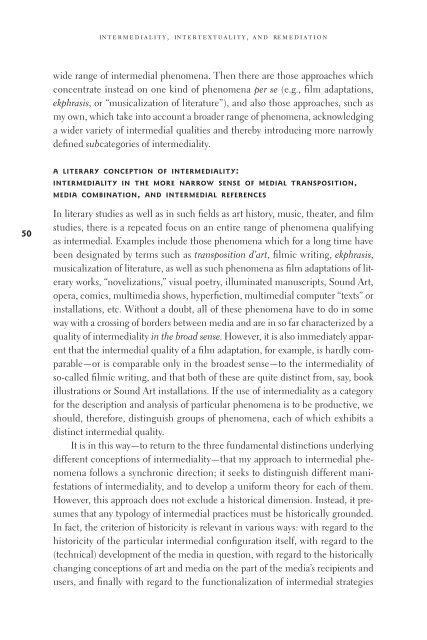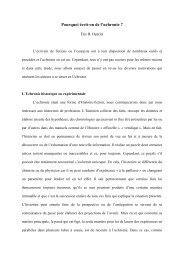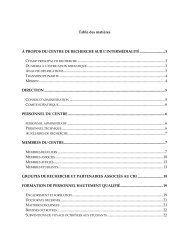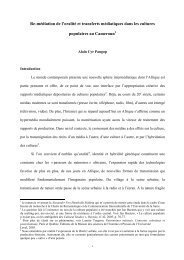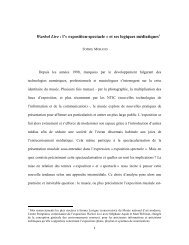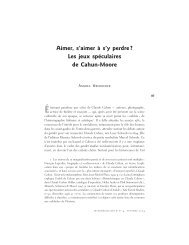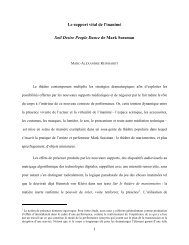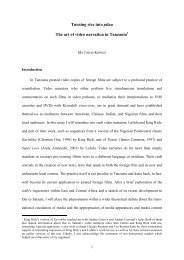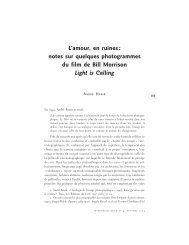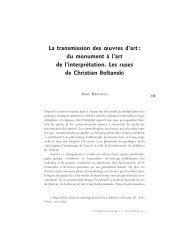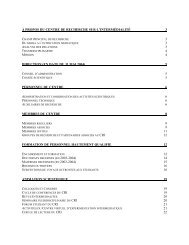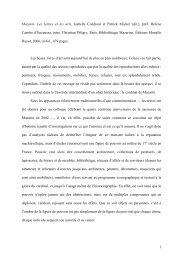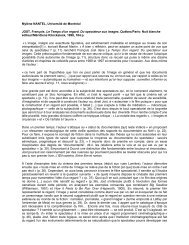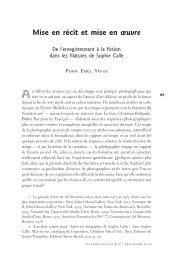Intermediality - Centre de recherche sur l'intermédialité (CRI ...
Intermediality - Centre de recherche sur l'intermédialité (CRI ...
Intermediality - Centre de recherche sur l'intermédialité (CRI ...
Create successful ePaper yourself
Turn your PDF publications into a flip-book with our unique Google optimized e-Paper software.
50<br />
intermediality, intertextuality, and remediation<br />
wi<strong>de</strong> range of intermedial phenomena. Then there are those approaches which<br />
concentrate instead on one kind of phenomena per se (e.g., fi lm adaptations,<br />
ekphrasis, or “musicalization of literature”), and also those approaches, such as<br />
my own, which take into account a broa<strong>de</strong>r range of phenomena, acknowledging<br />
a wi<strong>de</strong>r variety of intermedial qualities and thereby introducing more narrowly<br />
<strong>de</strong>fi ned subcategories of intermediality.<br />
A LITERARY CONCEPTION OF INTERMEDIALITY:<br />
INTERMEDIALITY IN THE MORE NARROW SENSE OF MEDIAL TRANSPOSITION,<br />
MEDIA COMBINATION, AND INTERMEDIAL REFERENCES<br />
In literary studies as well as in such fi elds as art history, music, theater, and fi lm<br />
studies, there is a repeated focus on an entire range of phenomena qualifying<br />
as intermedial. Examples inclu<strong>de</strong> those phenomena which for a long time have<br />
been <strong>de</strong>signated by terms such as transposition d’art, fi lmic writing, ekphrasis,<br />
musicalization of literature, as well as such phenomena as fi lm adaptations of literary<br />
works, “novelizations,” visual poetry, illuminated manuscripts, Sound Art,<br />
opera, comics, multimedia shows, hyperfi ction, multimedial computer “texts” or<br />
installations, etc. Without a doubt, all of these phenomena have to do in some<br />
way with a crossing of bor<strong>de</strong>rs between media and are in so far characterized by a<br />
quality of intermediality in the broad sense. However, it is also immediately apparent<br />
that the intermedial quality of a fi lm adaptation, for example, is hardly comparable—or<br />
is comparable only in the broa<strong>de</strong>st sense—to the intermediality of<br />
so-called fi lmic writing, and that both of these are quite distinct from, say, book<br />
illustrations or Sound Art installations. If the use of intermediality as a category<br />
for the <strong>de</strong>scription and analysis of particular phenomena is to be productive, we<br />
should, therefore, distinguish groups of phenomena, each of which exhibits a<br />
distinct intermedial quality.<br />
It is in this way—to return to the three fundamental distinctions un<strong>de</strong>rlying<br />
different conceptions of intermediality—that my approach to intermedial phenomena<br />
follows a synchronic direction; it seeks to distinguish different manifestations<br />
of intermediality, and to <strong>de</strong>velop a uniform theory for each of them.<br />
However, this approach does not exclu<strong>de</strong> a historical dimension. Instead, it presumes<br />
that any typology of intermedial practices must be historically groun<strong>de</strong>d.<br />
In fact, the criterion of historicity is relevant in various ways: with regard to the<br />
historicity of the particular intermedial confi guration itself, with regard to the<br />
(technical) <strong>de</strong>velopment of the media in question, with regard to the historically<br />
changing conceptions of art and media on the part of the media’s recipients and<br />
users, and fi nally with regard to the functionalization of intermedial strategies


